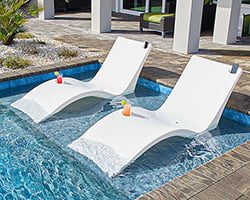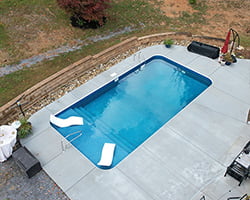If you’re not using a salt system, learning How Much Chlorine and pH For Good Pool Water level is crucial. It’s what keeps your pool free of microorganisms and infectious contaminants as well as keeping swimmers happy and comfortable. Not quite sure how these elements work? We’ve got the answers to all the most common questions about swimming pool chlorination and pH levels, learn how much Chlorine and pH For Good Pool Water!
Before we start:
- Buy only what you think you’ll use for the season- pool chemicals generally lose potency over time.
- Store your pool chemicals in a dry, cool, dark place. Sunlight can affect the chemical composition of some liquids.
- Avoid chemical vapor inhalation. This can be dangerous, especially in people with existing respiratory issues.
- Always make sure to follow the manufacturer’s instructions.
pH Levels
pH is the measurement of a solution’s acidity. The scale goes from 0, being the most acidic, to 14, the most basic, with 7 being neutral. The optimal level for pool water is around 7.4, as it keeps your pool clean without irritating your eyes and skin. If your pH level is too high (above 8) you risk skin irritation, lime buildup, cloudy water, and poor disinfection. With a level too low (below 7) you’ll have aggressively acidic water that can damage your pool liner, cause eye and nasal irritation and even damage components of your pool.
How to Raise/Lower pH
To lower pH: The most common way people lower their pH is by using muriatic acid, also known as hydrochloric acid.
To raise pH: Typically, soda ash (sodium carbonate) is used, though baking soda (sodium bicarbonate) can also be used. It should be noted, however, that baking soda will also raise alkalinity (level of dissolved materials that keep pH stable).
In both cases, make sure that you add small amounts before retesting your water to ensure thorough circulation. A local pool chemical supply store should be able to help you determine how much chemical you need based on your individual water test.
How Chlorine Affects pH Level

Chlorination
Chlorine is the chemical most often used to kill bacteria and microorganisms that are harmful to humans. The way it works is the chlorine solution breaks down into several components, including hypochlorous acid (HOCI) and hypochlorite ions (OCI-). These components destroy cell walls of the potentially hazardous organisms, rendering them harmless. As time goes on, these chemicals will eventually be broken down and more chlorine will have to be added. The goal for total chlorine level is around 0.5 to 1.5 ppm.
Another reaction in the pool is the conversion of chlorine into combined chlorine (or chloramines.) This chemical is a large factor in irritation while swimming, and it’s inefficient at cleaning. To reduce the presence of combined chlorine, the pool should be shocked with calcium hypochlorite. This will temporarily spike chlorine content levels but this will dissipate quickly.
Another thing to note is that when organic chlorine is used regularly, your pool will experience an increase in cyanuric acid. Cyanuric acid is a chemical that inhibits the effectiveness of chlorine, so you should try to keep levels down. This can be done by adding regular, untreated water to the pool. You should aim to keep your cyanuric acid levels below 20 ppm (parts per million.)
If you’re interested in a different method of keeping your pool clean, check out our article on salt-water pool systems or if you have questions, feel free to call us!
How Much Chlorine and pH For Good Pool Water
Americas #1 source for all backyard needs since 1996
Open:
Phone: 800-515-1747
Pool Warehouse, Backyard Dream Makers






 What are our customers saying?
What are our customers saying?

